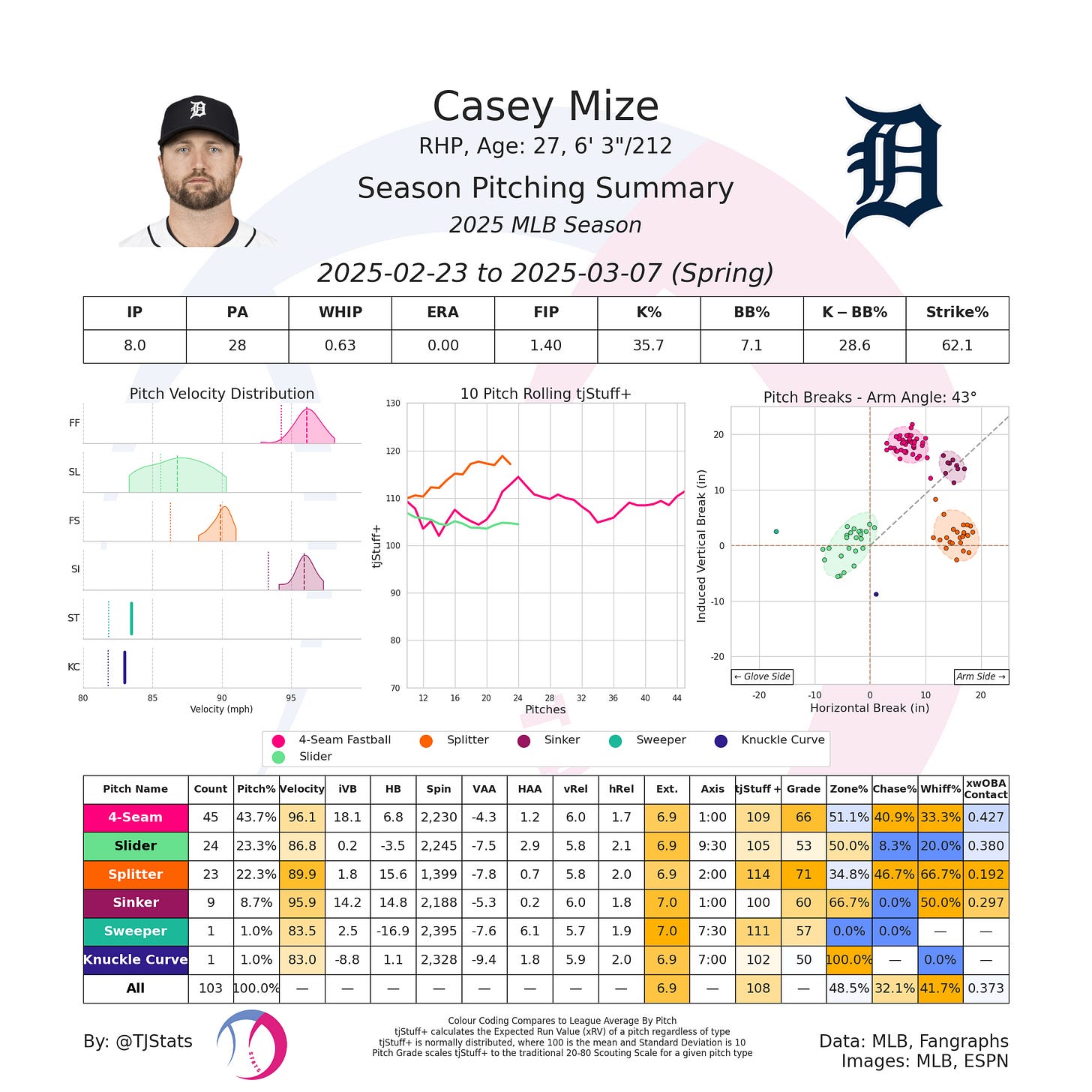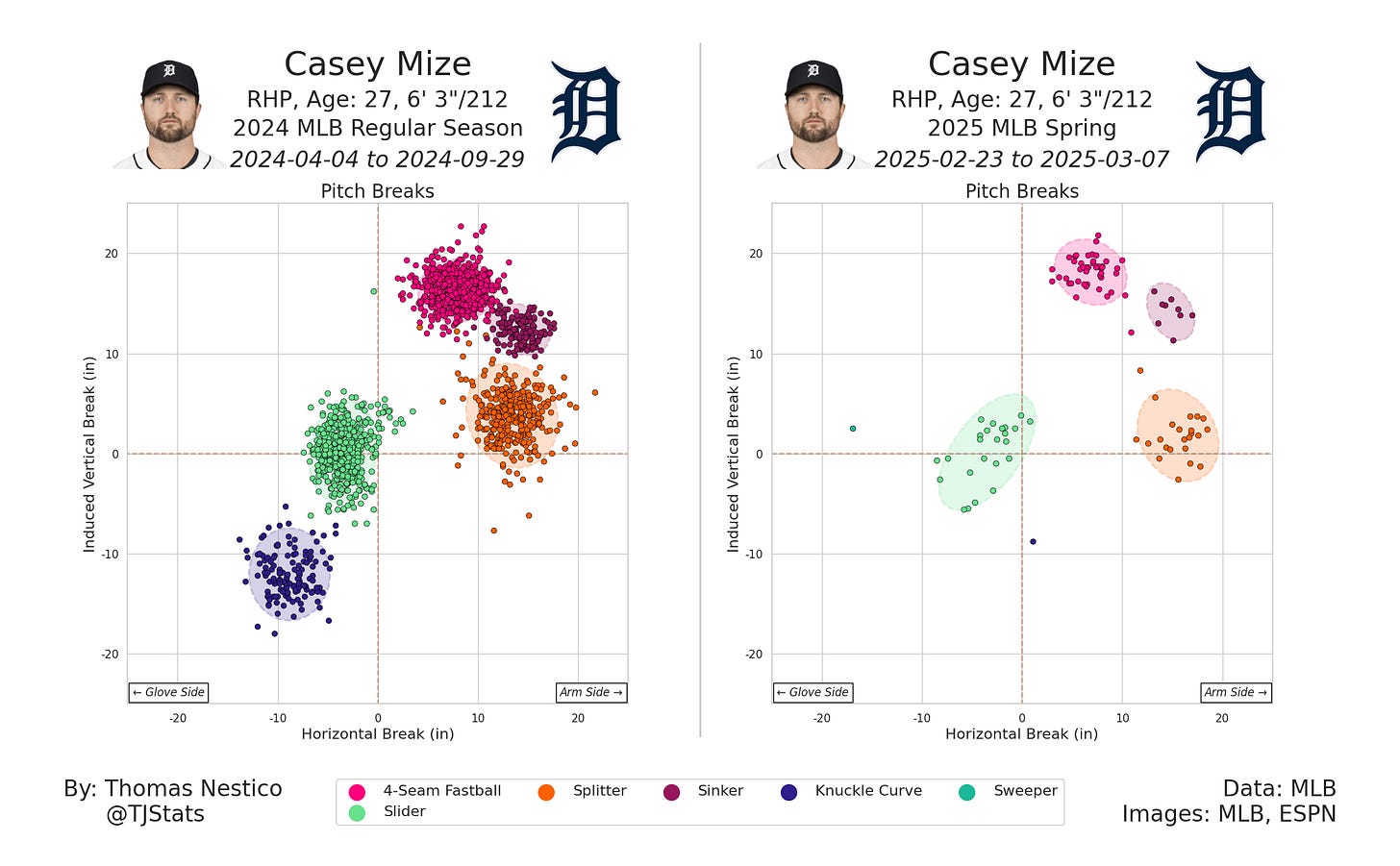Welcome to “Spring Scouting”, a series which aims to highlight any intriguing Spring Training players or storylines. This article will cover 5 pitchers that have caught my eye this Spring.
Casey Mize - DET
Casey Mize looks like a brand-new pitcher this Spring! Well, that may be a hyperbole because his arsenal hasn’t changed much, but the metrics on each pitch have significantly improved compared to last season.
Firstly, he adjusted his slot. Mize is releasing the ball ~2” higher than last season, and while that may not seem like a lot, it greatly impacts his delivery and how his pitches move. With this higher slot Mize has been able to maintain improved velocity throughout his starts and reshape his arsenal. His fastball has seen a drastic increase in induced vertical break without any other drawbacks. The pitch jumped from 101 tjStuff+ (average) to 109 tjStuff+ (plus) and has returned a gaudy 40.9 Chase% and 33.3 Whiff% this Spring. The added ride on the offering helps it play exceptionally well at the top of the zone. It is a small sample, but the fastball it is safe to say that Mize’s fastball has evolved.
The next most notable change comes in the form of his splitter. Last season the offering was pedestrian as it was seemingly average all around except for the immense damage it allowed (0.418 xwOBACON). Mize heavily struggled against LHH, and his splitter simply was not effective enough. Fast forward to this Spring and the transformation of Mize’s splitter may be the biggest glow up in the league! After sitting in the mid-80s in 2024, Mize is averaging 90 MPH on the offering while generating significantly more run and drop. These changes converted the pitch into more of a “splinker” and shot its tjStuff+ grade from 102 (average) to 113 (elite).
Another interesting note is that Mize has phased out his curveball after it was mostly ineffective last season. He also introduced a new sweeper, but has only thrown it once time.
Mize has caught the eye of many baseball fans this Spring and all the data backs it up. The former 1st overall pick has made the necessary changes to make that next step and develop into one of the strongest pitchers in the AL Central.
Max Meyer - MIA
Max Meyer has had a similar career arc as Casey Mize. Both were highly touted draft prospects but neither have found their footing at the Major League level due to injuries and inconsistencies, but now they look ready to take the league by storm this Spring.
Meyer made a change to his slot this Spring, lowering his arm angle which in turn lowered his vertical release point ~2”. As we saw with Mize, these seemingly small adjustments can pay big dividends. In Meyer’s case, he has improved his fastball velocity +2 MPH while also getting more iVB on the offering. Typically, it is common to see a decrease in fastball iVB as your vertical release point drops. This occurs because it becomes increasingly more difficult to impart the backspin required to lift the ball as your fingers are no longer be “ripping” the ball from the top. What we are seeing with Meyer, is that he has been able to improve his iVB with this lower arm angle which creates “unexpected movement” for his slot. With the improvements to velocity and shape, Meyer’s fastball improved from 95 tjStuff+ (below avarege) to 102 tjStuff+ (average).
Meyer’s bread and butter has always been his slider. It was his best pitch when he was drafted, and it has been his best offering in pro-ball. With the velocity gains he has seen in the Spring, Meyer is now throwing one of the hardest gyro-sliders in baseball. The offering is averaging 91 MPH with extremely tight movement. His feel for the offering is good and its bullet shape should make it a platoon neutral.
In addition to levelling up his fastball and slider, Meyer has refined both his sinker and changeup to have more deviation from his 4-Seam fastball. We haven’t seen much of these offering during the Spring, but these changes make me optimistic that he will have better results against LHH this season. He has also started throwing a new sweeper which has laughably good traits.
The Marlins revamped their entire pitching development team this offseason and it looks like they are making all the right decisions with Max Meyer.
Emilano Teodo - TEX
Emilano Teodo is one of my favourite pitching prospects, and his production this Spring has strengthened my convictions. Teodo wields a high 90s sinker and a hard 2-plane slider that helped his cruise through AA last season. He also tosses an unrefined low 90s changeup that will the key for Teodo to stick as a starter.
This Spring, Teodo has been used out of the bullpen where his blistering 2-pitch mix has handily dealt with batters. It has gotten to the point where Teodo is in the mix for the Rangers closer role at the start of the season. Bruce Bochy poured cold water on the chatter as the Rangers plan to develop Teodo as a SP; as they have throughout his pro career. Although I would love to see Teodo break camp with the team, I support the decision because I believe that he can develop into flamethrowing mid-rotation starter.
Teodo may not be up at the start of the season, but his stuff could make it very difficult for the Rangers to keep him down for long. He will likely start the season in AAA and be knocking on the door from the get go.
Bradley Blalock - COL
A Rockies pitcher doing well away from Coors isn’t anything new. Bradley Blalock had a rough debut in Colorado last year as he posted a 5.87 ERA and 5.61 FIP across 29.2 IP with his away stats being worse than when he played in Coors.
This Spring, Blalock has pitched to the tune of a 28.6 K-BB% across 7.0 IP while showing greater velocity and better feel for his offerings. His fastball isn’t particularly standout, but he is averaging ~1 MPH more on the pitch which has helped push its grade closer to average.
The biggest reason why Blalock has stood out to me his Spring is his splitter. It was easily his worst offering last season, and he showed a lot of inconsistencies with its movement. It got to the point where his splitter was so erratic that it would sometimes have iVB reminiscent of his fastball. And to hammer home why this wasn’t a “Coors” issue, Blalock’s splitter average 9” of iVB on the road compared to 6” iVB at home. Fast forward to this Spring, Blalock seems to have honed in on his feel for the offering while maintaining a large vertical separation from his fastball all while away from Coors. I would expect less horizontal movement when he pitches at home, but the iVB will be key to his success.
Blalock also tosses a trio of breaking balls which all grade out well and has strong results last season. Additionally, his home/away tjStuff+ on these pitches did not significantly change.
Navigating Coors is a tough battle for all pitchers, but Blalock’s arsenal seems poised to deal with the harsh conditions. I am not a big fan of his fastball in Colorado, but his secondaries have really impressed me this Spring.
Landen Roupp - SFG
Landen Roupp really deserves a spot in the Giants rotation. Unfortunately, the Giants have a log jam of veteran arms that are signed to substantial deals which will make it incredibly difficult for Roupp to break camp. Despite his inevitable AAA demotion, Roupp has been one of the best pitchers this Spring. He has fired off 8.1 IP with a 0.00 ERA and 1.23 FIP while only walking 1 batter.
Roupp has been one of the better MiLB pitchers during his pro career thanks to his innate ability to induce weak contact. His curveball is a marvelous pitch with nearly 20” of glove-side movement and great depth. He mirrors the sweeper with a big arm-side moving sinker that causes a lot of groundballs. His changeup is also a strong offering as it slips under his sinker which helps turn it into a whiff inducing machine against LHH.
The biggest development with Roupp this Spring is the introduction of his new cutter. In the process of adding this new pitch he has also stopped tossing this slider and 4-Seam fastball. I like this change as both those offering were inconsistent last season and were not effective at shutting down LHH. His new cutter gives him a platoon neutral offering that sits between his extreme E-W arsenal and helps bridge everything together.
The results have been fruitful thus far in the Spring, and it really seems like the Giants have gone with the “Logan Webb” blueprint for Roupp. Both are low slot righties with wide E-W arsenals that have toyed with a cutter to help diversify their approach.
Follow me on Twitter: @TJStats
Follow me on BlueSky: @tjstats.nesti.co
Consider Supporting me on Patreon: TJStats














Great read!